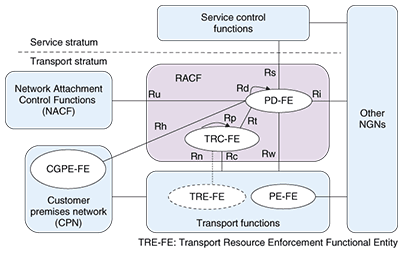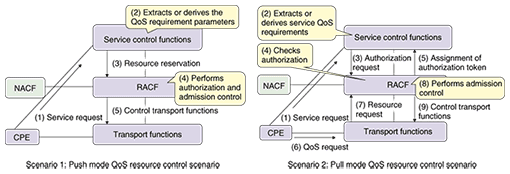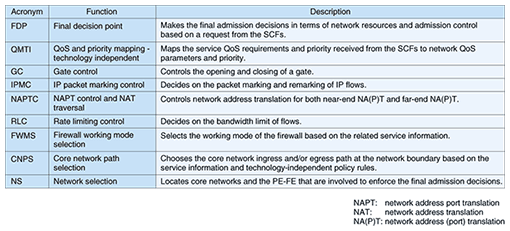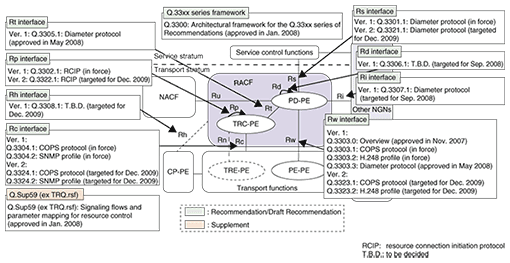 |
|||||||||||||||||
|
|
|||||||||||||||||
|
Global Standardization Activities Vol. 6, No. 12, pp. 28–33, Dec. 2008. https://doi.org/10.53829/ntr200812gls Standardization Activities for Resource and Admission Control Functions in Next Generation NetworksAbstractIn January 2008, ITU-T (International Telecommunication Union, Telecommunication Standardization Sector) specified the resource and admission control architecture and protocols in the primary set of Recommendations for the Next Generation Network (NGN). Enhancements of the functionalities to support advanced services, such as IPTV (Internet protocol television) services, are being discussed. This article describes recent standardization activities concerning resource and admission control functions in ITU-T SG13 (Study Group 13) and the status of the corresponding protocol development in ITU-T SG11.
1. Standardization activities for resource and admission control functions in ITU-TIn ITU-T (International Telecommunication Union, Telecommunication Standardization Sector), from the beginning of the study of the Next Generation Network (NGN), resource and admission control functions, architecture, and protocols have been considered as one of the key functionalities in the NGN and intensively discussed [1]. The initial activities were started in the Focus Group on NGN (FG-NGN), and the discussion results were transferred to Study Group 13 (SG13) Question 4/13. Work on SG13 Q.4/13 started in April 2005 and it was agreed to start the Alternative Approval Process (AAP) in September 2006 to publish Recommendation Y.2111, Resource and admission control functions in Next Generation Networks. In January 2008, ITU-T specified the resource and admission control architecture and protocols in the primary set of Recommendations. Currently, Revision 1 of Y.2111 is being discussed to enhance functionalities, such as multicast resource controls scenarios and customer premises network reference point. 2. Resource and admission control architecture in Y.2111 (RACF)The generic architecture of resource and admission control functions (RACF) in Y.2111 Revision 1 under discussion is shown in Fig. 1. In Y.2111, when a service request is received from a user, the current network resource usage status is checked to see whether the requested service can be offered with a guaranteed quality of service (QoS). This functionality enables existing services to keep their quality status and prevents excess usage of the network resources that might cause QoS degradation.
As shown in Fig. 1, Y.2111 defines two primary functional entities: PD-FE (Policy Decision Functional Entity) and TRC-FE (Transport Resource Control Functional Entity). PD-FE provides a single contact point for the service control functions (SCFs) and offers functionalities, such as making the final decision regarding network resource and admission control based on network policy rules. PD-FE also controls the gates in the transport functions (i.e., routers). TRC-FE corrects and maintains the resource status information in the network and provides the resource-based admission control decision results to PD-FE. The resource control architecture of Y.2111 is independent of the physical implementation of the access and core networks and aims to provide a general resource control framework. As a result, the architecture is consistent with the resource and admission control subsystem (RACS) architecture defined in ETSI TISPAN [2]. Two QoS resource control scenarios are shown in Fig. 2: a Push mode QoS resource control scenario (Scenario 1) and a Pull mode QoS resource control scenario (Scenario 2). These two scenarios are defined taking into account the different QoS capabilities of customer premises equipment (CPE). Scenario 1 is for CPE that does not have QoS negotiation capability, such as fixed-line terminals. The SCFs are responsible for deriving the QoS needs of the requested service and sending a request to the RACF for QoS authorization and reservation. Scenario 2 assumes that the CPE can support QoS negotiation, like a mobile terminal. The CPE sends a service request to the SCFs, and they send an authorization request to the RACF. The RACF checks authorization based on network policy rules and sends back an authorization token to the CPE. The CPE initiates a request with the authorization token through dedicated path-coupled transport QoS signaling. By supporting both Push and Pull mode QoS control scenarios, Y.2111 can offer an optimum resource control scheme for various terminals having different QoS negotiation capabilities.
The elementary functions for PD-FE and TRC-FE are summarized in Tables 1 and 2, respectively. PD-FE provides transport functions, PE-FE (Policy Enforcement Functional Entity), transport control information, such as gate control, bandwidth allocation, rate limiting, IP packet marking, NAPT control, etc. TRC-FE collects and maintains the network information and resource status information, and it provides this transport control information to PD-FE based on the transport status information.
3. Functional enhancements of resource and admission control architecture in Y.2111 Revision 1The initial target of Y.2111 was mainly telephone services and multimedia conference services [3]. Y.2111 Revision 1 is currently being discussed to support resource and admission control mechanisms for IPTV (Internet protocol television) services. In May 2008, the scope of Y.2111 Revision 1 was discussed, and the following items will be included as functional enhancements of Y.2111. (1) Addition of CGPE-FE Addition of CGPE-FE (CPN Gateway Policy Enforcement Functional Entity) in the generic functional architecture was discussed, and CGPE-FE is being defined to enforce the transport policy rules in the customer premises network (CPN) for upstream traffic instructed by the PD-FE. (2) Creation of Rh reference point The creation of an Rh reference point in the generic functional architecture was discussed, and the Rh reference point is being defined to enforce the transport policy rules in the CPN for upstream traffic instructed by the PD-FE. The Rh reference point allows the final admission decisions to be installed in the CGPE-FE by the PD-FE. Y.2111 Revision 1 deals with only this scenario and the case where the policy decision functional entity placed in the CPN is for further study [4]. (3) Addition of multicast resource control scenarios Multicast resource control scenarios for IPTV services are added in Y.2111 Revision 1. Scenario 1 is for the case where the resource control request is triggered from transport functions (e.g., using IGMP (Internet group management protocol) or MLD (multicast listener discovery)). In this Scenario 1, the CPE requests a multicast service by sending transport signaling to the transport functions. When they receive the service request from the CPE, the transport functions perform multicast control and send a resource reservation request to the PD-FE. Scenario 2 is the case where the SCFs send a resource control request to the PD-FE. The CPE requests a multicast service by sending a service request to the SCFs. When it receives the service request from the CPE, the SCFs perform service control and sends a resource reservation request to the PD-FE. If the request is granted, the PD-FE will push the policy decisions to the transport functions. Y.2111 Revision 1 considers three types of resource control approaches for multicast and unicast services.
Details of the resource control deployment scenarios for multicast are given in Appendix VI of Y.2111 Revision 1. The functional enhancements described above make it possible to offer users bandwidth-guaranteed multicast services concurrently with bandwidth-guaranteed unicast services. It is also expected that it will be possible to use the Rh reference point to control the CPN transport functions considering the current network usage status of the CPN and to offer end-to-end optimum bandwidth resource control. 4. Resource and admission control protocol developments in Q.33xx seriesIn line with the resource and admission control architecture requirements, Study Group 11, Question 5/11 has been conducting intensive discussion of these protocol developments since November 2005. The statuses of resource and admission control protocol Recommendations are summarized in Fig. 3. ITU-T Recommendation Q.3300 describes the resource control protocol framework of the Q.33xx series Recommendations. The protocol development statuses of the primary interface are as follows [4]:
(1) Rs interface: Q.3301.1 specifies a protocol between service control entities (SCEs) in the Services stratum and the Policy Decision Physical Entity (PD-PE) in the RACF block. The Diameter Base Protocol specified in RFC 3588 is used to support information transfer on the Rs interface. Upon receiving a session signaling message initiating a new SCE session, the SCE requests authorization for the session from the PD-PE by sending an appropriate Diameter AVP (attribute-value pair). (2) Rw interface: This interface defines a protocol between the PD-PE and a Policy Enforcement Physical Entity (PE-PE). There are three signaling alternatives for the Rw interface defined in protocol-specific Recommendations Q.3303.1 (COPS (common open policy service) protocol), Q.3303.2 (H.248 profile), and Q.3303.3 (Diameter protocol). (3) Rc interface: This interface is defined for a Transport Resource Control Physical Entity (TRC-PE) to collect network topology and resource status information from elements of an access network or core network. There are two signaling alternatives for the Rc interface defined in protocol-specific Recommendations Q.3304.1 (COPS protocol) and Q.3304.2 (SNMP (simple network management protocol) profile). Enhancements for the protocol specifications of the interfaces in line with the functional extensions to be defined in Y.2111 Revision 1 are being discussed as the set of Version 2 protocols. 5. ConclusionThis article described the status of the standardization of NGN resource and admission control functions, architecture, and protocols in ITU-T SG13 and SG11. The initial target of Y.2111 was mainly telephone services and multimedia conference services, but Y.2111 Revision 1 is currently being discussed to support resource and admission control mechanisms for IPTV services. In line with the enhancements of the architecture and functionalities, the relevant protocol work is being intensively performed as the Q.33xx series of ITU-T Recommendations and the subsequent Version 2 activities. Capitalizing on its pioneering experiences in Japan's broadband environment, NTT Laboratories is committed to making significant contributions to NGN international standardization in the years to come. References
|
|||||||||||||||||















